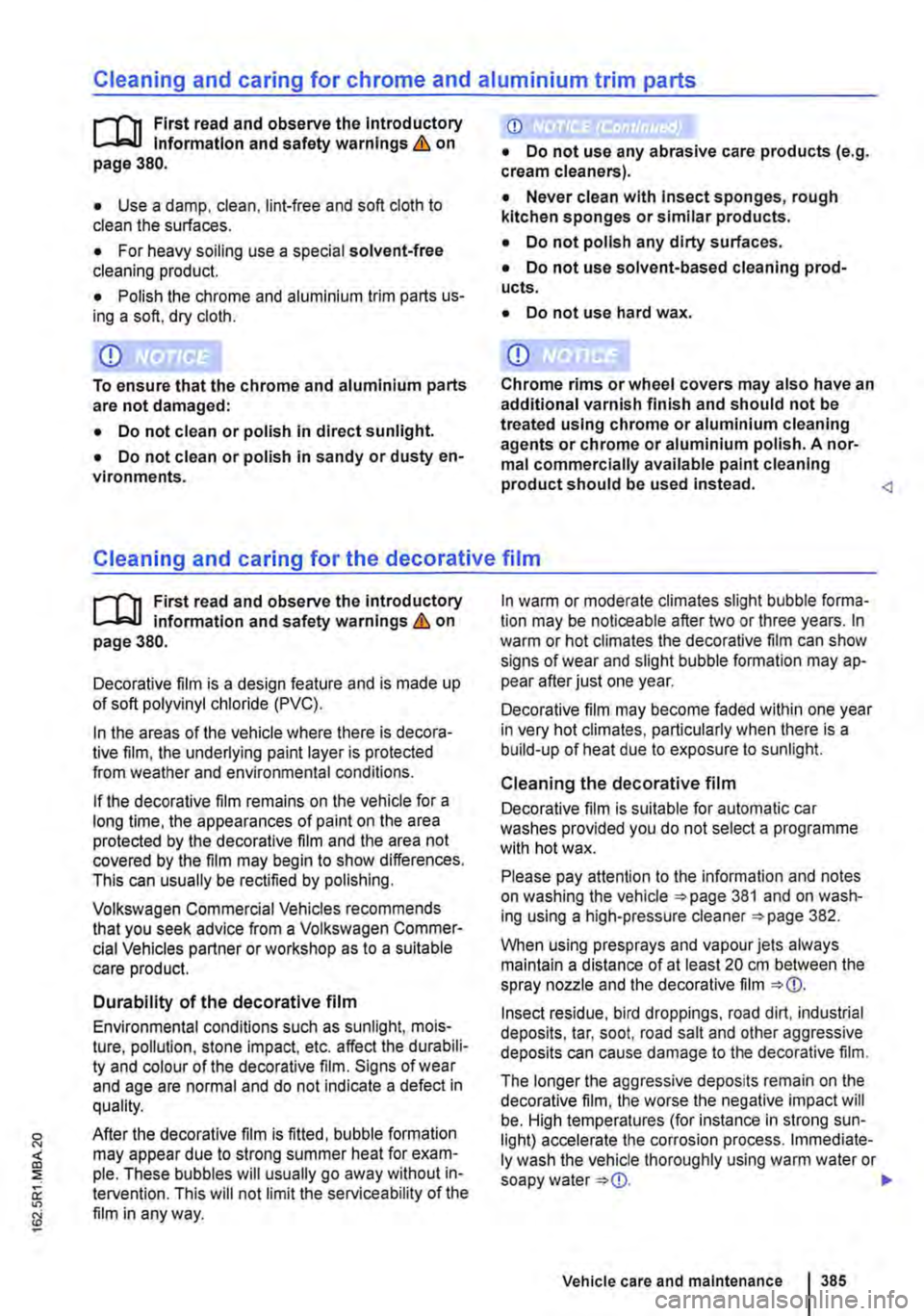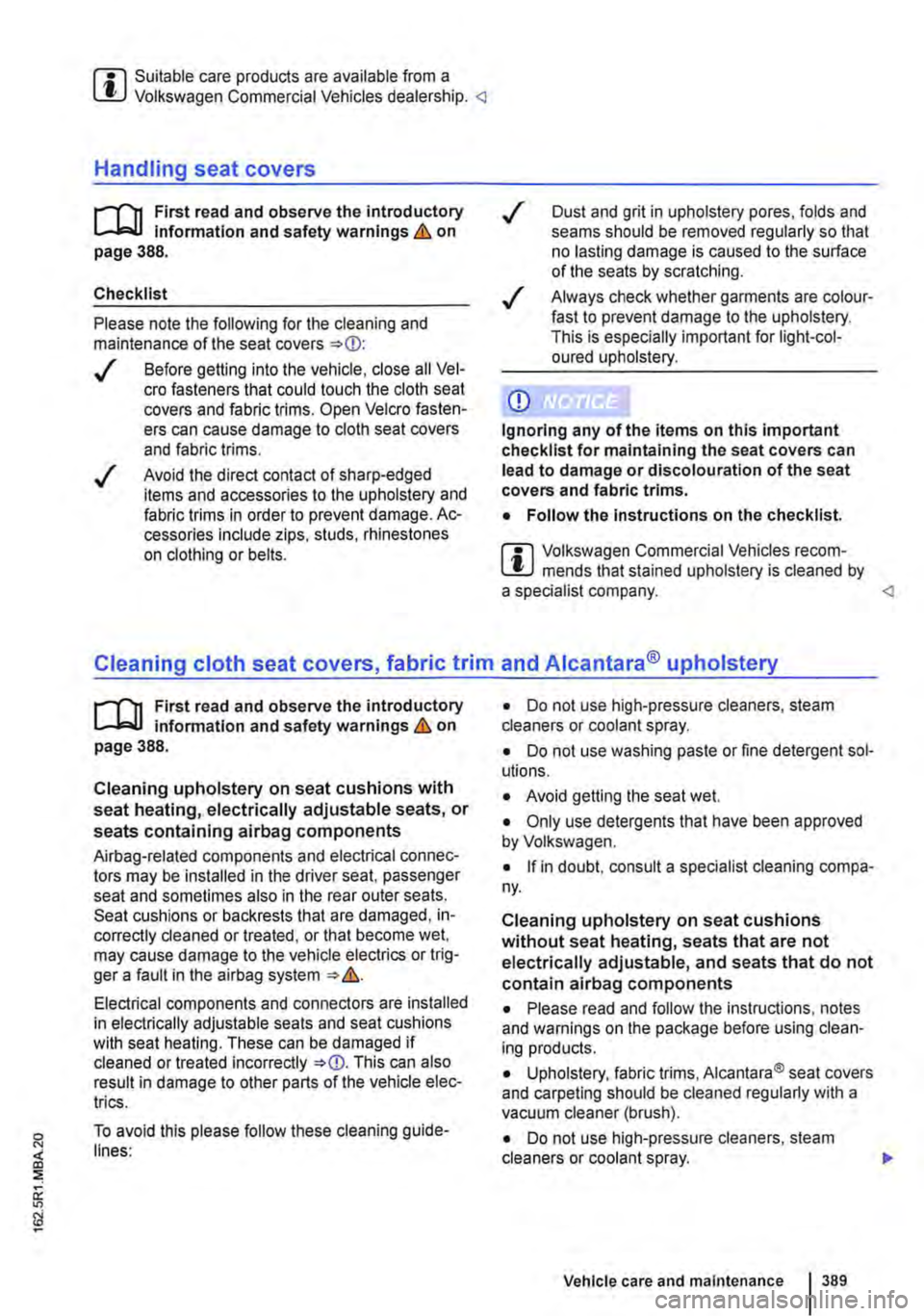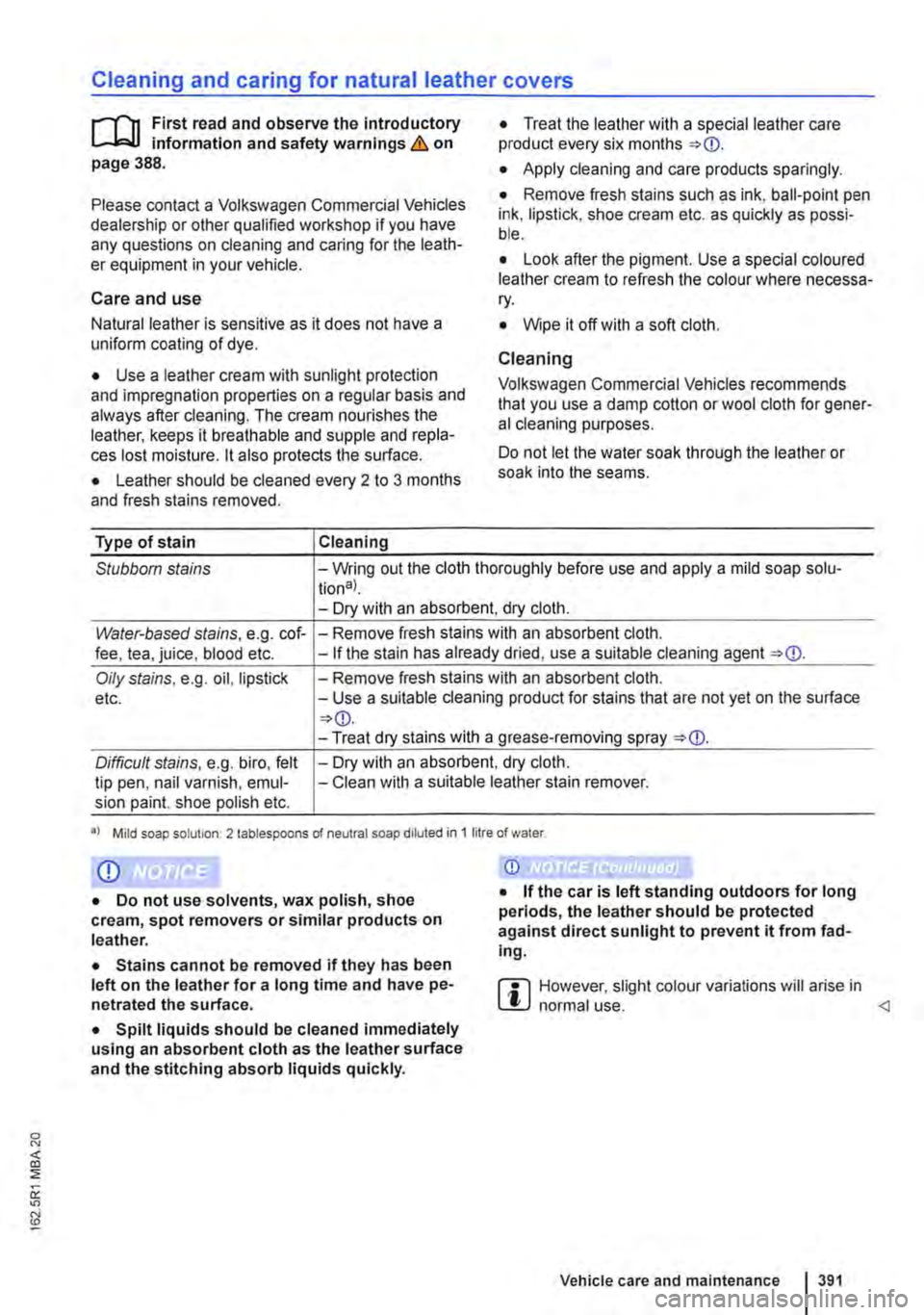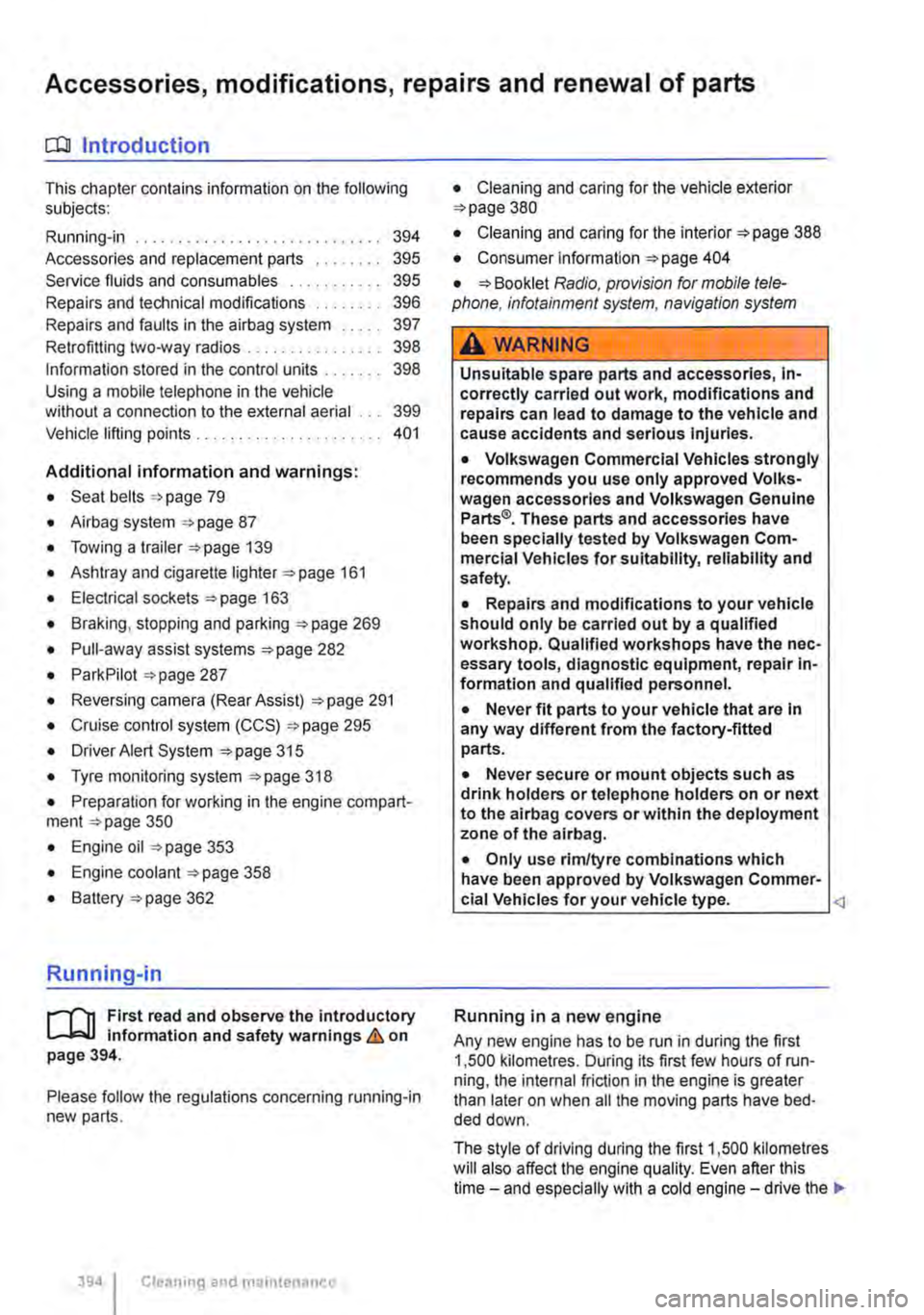2010 VOLKSWAGEN TRANSPORTER ESP
[x] Cancel search: ESPPage 376 of 486

=>Fig. 284 Tyre lettering (example) I Meaning
JHCO CHWS 2213 Tyre identification number (TINa)-may only be on the inner side of the wheel) and date of manufacture:
® JHCO Identifier of producing plant and specifications of CHWS the tyre manufacturer on size and characteristics
2213 Manufacture date: 22nd week in 2013.
Information for the end user concernmg comparat1ve values for spec1fied bas1c tyres (standardised test procedure) =>page 404·
TREADWEAR 280 Relative life expectancy for the tyre, with reference to a US-specific standard test. Tyres with the specification 280 are used up at a rate of 2.8 times more slowly than standard tyres
@ which have a treadwear value of 100. The performance of tyres is determined by how they are used and can notably de-viate from norm values due to driving style, maintenance, road surface and climatic conditions.
TRACTION AA Wet braking response of the tyre (AA, A, B or C). This is tes-led under controlled conditions on certified testing routes.
® Tyres marked C have a low traction performance. The traction value assigned to the tyres are based on linear traction tests and do not include speed, lateral stability, or aquaplaning and traction under high load.
TEMPERATURE A Temperature stability of the tyre at higher test speeds (A, B or C). A and B tyres exceed legal requirements. The tempera-tu re evaluation is based on tyres with correct pressure and
® does not allow for excess pressure. Excessive speed, incor-reel pressure or excess pressure can cause heat build-up or tyre damage. This applies to one or a combination of these factors.
0 88 H Load capacity index ::.page 377 and speed index ::.page 377.
® Rotation and arrow Denotes direction of rotation ::.page 377.
OR: outside Denotes outside of tyres ::.page 377.
® MAX INFLATION 350 KPA US limitation for the maximum air pressure. (51 psi /3.51 bar)
® M+S or M/S or & Denotes winter tyres (mud and snow tyres) ::.page 378. Studded snow tyres are labelled with an E after the S.
® TWI Indicates the position of the tread wear indicator ::.page 372.
@ Brand name. logo Manufacturer.
@ Made in Germany Country of manufacture.
@> @ Country-specific denotation for China (China Compulsory Certification).
® :r 023 Country-specific denotation for Brazil.
E4 e4 0200477-b Certification of conformity with international regulations. The next number is the code number of the country that granted
® approval. Approved tyres which comply with ECE regulations are denoted with E. tyres which comply with EC regulations are denoted with e. This is followed by the number of the type approval certificate.
@ RADIAL TUBELESS Tubeless radial tyres.
376 I Cleaning and maintenance
Page 378 of 486

z
w y
over 240 km/h (149 mph)
max. 270 kmlh (168 mph)
max. 300 kmlh (186 mph)
Winter tyres
r-f'n First read and observe the introductory L-J,::JJ information and safety warnings & on page 367.
In winter road conditions, winter tyres will consider-ably improve the car's handling. The design of summer tyres (width, rubber compound, tread pat-tern) gives less grip on ice and snow. Volkswagen Commercial Vehicles urgently recommends you use winter tyres or all-year tyres on all 4 wheels of the vehicle, particularly if winter conditions are ex-pected on the roads. Winter tyres will also improve the braking response of the vehicle and will help to reduce braking distances in winter weather. Volks-wagen Commercial Vehicles recommends that win-ter tyres be fitted to the vehicle at temperatures un-der+ 7•c (+45°F).
Winter tyres lose their effectiveness when the tread is worn down to a depth of 4 mm. Winter tyres also largely lose their effectiveness through ageing-regardless of the tread depth.
The following applies when using winter tyres:
• Observe any country-specific legal require-ments.
• Use winter tyres on all four wheels at the same time.
• Only use in winter road conditions.
• Only use the sizes of winter tyre that have been approved for the vehicle.
• Winter tyres must have the same type, size (rolling circumference) and the same tread pattern.
• Heed the maximum speed permitted by the speed index => &.
Speed limitation
Winter tyres have a speed limitation depending on the speed index =>page 375.
In some vehicle versions, a speed warning can be set in the menu MFD (multi function display) in the instrument cluster =>page 24.
378 I Cleaning and maintenance
Some tyre manufacturers use the code "ZR" for tyres with a highest permitted speed of over 240 km/h (149 mph).
If you use V-rated tyres the speed limits and re-quired tyre pressure will be determined by the en-gine size. You must ask a Volkswagen Commercial Vehicles dealership about the highest permitted speed and required tyre pressure.
Four-wheel drive (4MOTION)
Thanks to its four-wheel drive, the vehicle will have plenty of traction in winter conditions, even with the standard tyres. Nevertheless, Volkswagen Com-mercial Vehicles still recommends that winter tyres or all-year tyres should be fitted on all four wheels when winter road conditions are expected, mainly because this will give a better braking response.
Please refer to the appropriate information and notes when using snow chains =>page 379.
A WARNING
The Improved winter driving characteristics afforded by the winter tyres should not en-courage you to take any risks.
• Always adapt your speed and driving style to suit visibility, weather, road and traffic con-ditions.
• Never exceed the top speed and load per-mitted for the winter tyres that are fitted.
r:Q;-.. Summer tyres should be fitted in good time at the end of the winter. The vehicle handling is better if summer tyres are fitted at temperatures above +7•c (+45.F). They are quieter, do not wear so quickly and reduce fuel consumption.
m In vehicles with a tyre monitoring system, the l!.J systems have to "re-synchronise" after wheels are changed =>page 318.
m Volkswagen Commercial Vehicles dealer-l!.J ships can provide details on permissible win-
Page 379 of 486

Snow chains
r-"f"'n First read and observe the introductory L-J=.IJ information and safety warnings & on page 367.
Please heed legislation and also the permitted speed when driving your vehicle with snow chains.
In winter conditions, snow chains will not only im-prove acceleration, but also braking response.
Snow chains may only be fitted on the front wheels-even on four-wheel drive vehicles (4MOTION)-and only with the following wheel and tyre combinations:
Tyre size Wheel
205/65 R16 C 6 1/2 J x 16 offset 51 or61/2Jx16off-set 52
215/65 R16 C 6 112 J x 16 offset 51 or61/2 J x 16 off-set 52
215/60 R17 C 7 J x 17 offset 55 or 7 J x 17 offset 56
Volkswagen Commercial Vehicles recommends that you ask your Volkswagen Commercial Vehi-cles dealership for information about appropriate wheel, tyre and snow chain size.
If possible, use snow chains with fine-pitch links which do not protrude more than 15 mm, including the tensioner.
Remove wheel centre covers and trim rings before fitting snow chains For safety reasons cover caps must then be fitted over the wheel bolts. These are available from your Volkswagen Com-mercial Vehicles dealership.
A WARNING
The use of snow chains that are unsuitable for your vehicle or the incorrect installation of snow chains can cause accidents and seri-ous Injuries.
• Always use the correct snow chains.
• Follow the assembly instructions provided by the snow chain manufacturer.
• Never exceed the maximum speed permit-ted for the snow chains that are fitted.
Q)
• Remove the snow chains when driving on roads that are free of snow. The snow chains will otherwise impair handling, damage the tyres and wear out very quickly.
• Snow chains that are in direct contact with the wheel can scratch or damage it. Volkswa-gen Commercial Vehicles recommends using non-scratch snow chains.
m Snow chains are available in a range of sizes l!:.J for a vehicle type.
m When using snow chains on vehicles with a l!:.J tyre monitoring system, an incorrect display may be shown as the snow chains increase the tyre circumference 318.
Page 385 of 486

Cleaning and caring for chrome and aluminium trim parts
r-('n First read and observe the Introductory l..Jo:-1.1 Information and safety warnings & on page 380.
• Use a damp, clean, lint-free and soft cloth to clean the surfaces.
• For heavy soiling use a special solvent-free cleaning product.
• Polish the chrome and aluminium trim parts us-ing a soft, dry cloth.
CD
To ensure that the chrome and aluminium parts are not damaged:
• Do not clean or polish In direct sunlight.
• Do not clean or polish in sandy or dusty en-vironments.
CD
• Do not use any abrasive care products (e.g. cream cleaners).
• Never clean with Insect sponges, rough kitchen sponges or similar products.
• Do not polish any dirty surfaces.
• Do not use solvent-based cleaning prod-ucts.
• Do not use hard wax.
CD
Chrome rims or wheel covers may also have an additional varnish finish and should not be treated using chrome or aluminium cleaning agents or chrome or aluminium polish. A nor-mal commercially available paint cleaning product should be used instead.
r-('n First read and observe the introductory l..Jo:-1.1 information and safety warnings & on page 380.
Decorative film is a design feature and is made up of soft polyvinyl chloride (PVC).
In the areas of the vehicle where there is decora-tive film, the underlying paint layer is protected from weather and environmental conditions.
If the decorative film remains on the vehicle for a long time, the appearances of paint on the area protected by the decorative film and the area not covered by the film may begin to show differences. This can usually be rectified by polishing.
Volkswagen Commercial Vehicles recommends that you seek advice from a Volkswagen Commer-cial Vehicles partner or workshop as to a suitable care product.
Durability of the decorative film
Environmental conditions such as sunlight, mois-ture, pollution, stone impact, etc. affect the durabili-ty and colour of the decorative film. Signs of wear and age are normal and do not indicate a defect in quality.
After the decorative film is fitted, bubble formation may appear due to strong summer heat for exam-ple. These bubbles will usually go away without in-tervention. This will not limit the serviceability of the film in any way.
In warm or moderate climates slight bubble forma-tion may be noticeable after two or three years. In warm or hot climates the decorative film can show signs of wear and slight bubble formation may ap-pear after just one year.
Decorative film may become faded within one year in very hot climates, particularly when there is a build-up of heat due to exposure to sunlight.
Cleaning the decorative film
Decorative film is suitable for automatic car washes provided you do not select a programme with hot wax.
Please pay attention to the information and notes on washing the vehicle =>page 381 and on wash-ing using a high-pressure cleaner =>page 382.
When using presprays and vapour jets always maintain a distance of at least 20 cm between the spray nozzle and the decorative film =>CD.
Insect residue, bird droppings, road dirt, industrial deposits. tar, soot, road salt and other aggressive deposits can cause damage to the decorative film.
The longer the aggressive deposits remain on the decorative film, the worse the negative impact will be. High temperatures (for instance in strong sun-light) accelerate the corrosion process. Immediate-ly wash the vehicle thoroughly using warm water or soapy water =>CD. .,.
Vehicle care and maintenance 385
Page 389 of 486

m Suitable care products are available from a W Volkswagen Commercial Vehicles dealership.
r--f'n First read and observe the introductory L-J,::.U Information and safety warnings & on page 388.
Checklist
Please note the following for the cleaning and maintenance of the seat covers =>Q):
v' Before getting into the vehicle, close all Vel-era fasteners that could touch the cloth seat covers and fabric trims. Open Velcro fasten-ers can cause damage to cloth seat covers and fabric trims.
v' Avoid the direct contact of sharp-edged items and accessories to the upholstery and fabric trims in order to prevent damage. Ac-cessories include zips, studs, rhinestones on clothing or belts.
v' Dust and grit in upholstery pores, folds and seams should be removed regularly so that no lasting damage is caused to the surface of the seats by scratching.
v' Always check whether garments are colour-fast to prevent damage to the upholstery. This is especially important for light-col-oured upholstery.
CD
Ignoring any ofthe items on this important checklist for maintaining the seat covers can lead to damage or discolouration of the seat covers and fabric trims.
• Follow the Instructions on the checklist.
m Volkswagen Commercial Vehicles recom-l!.J mends that stained upholstery is cleaned by a specialist company.
r--f'n First read and observe the introductory L-J,::.IJ information and safety warnings & on page 388.
Cleaning upholstery on seat cushions with seat heating, electrically adjustable seats, or seats containing airbag components
Airbag-related components and electrical connec-tors may be installed in the driver seat, passenger seat and sometimes also in the rear outer seats. Seat cushions or backrests that are damaged, in-correctly cleaned or treated, or that become wet, may cause damage to the vehicle electrics or trig-ger a fault in the airbag system => &.
Electrical components and connectors are installed in electrically adjustable seats and seat cushions with seat heating. These can be damaged if cleaned or treated incorrectly =>Q). This can also result in damage to other parts of the vehicle elec-trics.
To avoid this please follow these cleaning guide-lines:
• Do not use high-pressure cleaners, steam cleaners or coolant spray.
• Do not use washing paste or fine detergent sol-utions.
• Avoid getting the seat wet.
• Only use detergents that have been approved by Volkswagen.
• If in doubt, consult a specialist cleaning compa-ny.
Cleaning upholstery on seat cushions without seat heating, seats that are not electrically adjustable, and seats that do not contain airbag components
• Please read and follow the instructions, notes and warnings on the package before using clean-ing products.
• Upholstery, fabric trims, Alcantara® seat covers and carpeting should be cleaned regularly with a vacuum cleaner (brush).
• Do not use high-pressure cleaners, steam cleaners or coolant spray.
Vehicle care and maintenance 389
Page 391 of 486

Cleaning and caring for natural leather covers
r-f"'n First read and observe the introductory L-.I.::.U information and safety warnings & on page 388.
Please contact a Volkswagen Commercial Vehicles dealership or other qualified workshop if you have any questions on cleaning and caring for the leath-er equipment in your vehicle.
Care and use
Natural leather is sensitive as it does not have a uniform coating of dye.
• Use a leather cream with sunlight protection and impregnation properties on a regular basis and always after cleaning. The cream nourishes the leather, keeps it breathable and supple and repla-ces lost moisture. lt also protects the surface.
• Leather should be cleaned every 2 to 3 months and fresh stains removed.
Type of stain Cleaning
• Treat the leather with a special leather care product every six months
• Apply cleaning and care products sparingly.
• Remove fresh stains such as ink, ball-point pen ink, lipstick, shoe cream etc. as quickly as possi-ble.
• Look after the pigment. Use a special coloured leather cream to refresh the colour where necessa-ry.
• Wipe it off with a soft cloth.
Cleaning
Volkswagen Commercial Vehicles recommends that you use a damp cotton or wool cloth for gener-al cleaning purposes.
Do not let the water soak through the leather or soak into the seams.
Stubborn stains -Wring out the cloth thoroughly before use and apply a mild soap solu-tional. -Dry with an absorbent, dry cloth.
Water-based stains, e.g. cof--Remove fresh stains with an absorbent cloth. fee, tea, juice, blood etc. -If the stain has already dried, use a suitable cleaning agent
Oily stains, e.g. oil, lipstick etc. -Remove fresh stains with an absorbent cloth. -Use a suitable cleaning product for stains that are not yet on the surface
-Treat dry stains with a grease-removing spray
Difficult stains, e.g. biro, felt tip pen, nail varnish, emul-sion paint. shoe polish etc.
-Dry with an absorbent, dry cloth. -Clean with a suitable leather stain remover.
•I Mild soap solut1on: 2 tablespoons of neutral soap diluted in 1 lilre of water
CD
• Do not use solvents, wax polish, shoe cream, spot removers or similar products on leather.
• Stains cannot be removed if they has been left on the leather for a long time and have pe-netrated the surface.
• Spilt liquids should be cleaned immediately using an absorbent cloth as the leather surface and the stitching absorb liquids quickly.
CD
• If the car is left standing outdoors for long periods, the leather should be protected against direct sunlight to prevent it from fad-Ing.
m However, slight colour variations will arise in W normal use.
Page 394 of 486

Accessories, modifications, repairs and renewal of parts
o::n Introduction
This chapter contains information on the following subjects:
Running-in 394
Accessories and replacement parts 395 Service fluids and consumables . . . . . . . . . . . 395
Repairs and technical modifications . . . . . . . . 396
Repairs and faults in the airbag system . . . . . 397
Retrofitting two-way radios . . . . . . . . . . . . . . . . 398
Information stored in the control units . . . . . . . 398 Using a mobile telephone in the vehicle without a connection to the external aerial . . 399
Vehicle lifting points 401
Additional information and warnings:
• Seat belts '*page 79
• Airbag system '*page 87
• Towing a trailer 139
• Ashtray and cigarette lighter 161
• Electrical sockets 163
• Braking, stopping and parking '*page 269
• Pull-away assist systems 282
• ParkPilot 287
• Reversing camera (Rear Assist) '*page 291
• Cruise control system (CCS) 295
• Driver Alert System 315
• Tyre monitoring system 318
• Preparation for working in the engine compart-ment page 350
• Engine oil 353
• Engine coolant '*page 358
• Battery 362
Running-in
r--('n First read and observe the introductory L-J.:.lJ information and safety warnings & on page 394.
Please follow the regulations concerning running-in new parts.
394 I Cleaning and maintenance
• Cleaning and caring for the vehicle exterior 380
• Cleaning and caring for the interior 388
• Consumer information 404
• Radio, provision for mobile tele-phone, infotainment system, navigation system
A WARNING
Unsuitable spare parts and accessories, In-correctly carried out work, modifications and repairs can lead to damage to the vehicle and cause accidents and serious Injuries.
• Volkswagen Commercial Vehicles strongly recommends you use only approved Volks-wagen accessories and Volkswagen Genuine Parts®. These parts and accessories have been specially tested by Volkswagen Com-mercial Vehicles for suitability, reliability and safety.
• Repairs and modifications to your vehicle should only be carried out by a qualified workshop. Qualified workshops have the nec-essary tools, diagnostic equipment, repair In-formation and qualified personnel.
• Never fit parts to your vehicle that are In any way different from the factory-fitted parts.
• Never secure or mount objects such as drink holders or telephone holders on or next to the airbag covers or within the deployment zone of the airbag.
• Only use rim/tyre combinations which have been approved by Volkswagen Commer-cial Vehicles for your vehicle type.
Any new engine has to be run in during the first 1 ,500 kilometres. During its first few hours of run-ning, the internal friction in the engine is greater than later on when all the moving parts have bed-ded down.
The style of driving during the first 1 ,500 kilometres will also affect the engine quality. Even after this time-and especially with a cold engine-drive the .,.
Page 395 of 486

vehicle at moderate speeds in order to reduce en-gine wear and to increase the mileage that the en-gine can cover. Do not drive at engine speeds that are too low. Always shift down gear if the engine is not running smoothly. The following applies up to 1,000 kilometres:
• Do not depress the accelerator fully.
• Do not drive the vehicle at more than 2/3 of the top engine speed.
• Do not drive with a trailer attached.
Accessories and replacement parts
r-1'11 First read and observe the introductory l-J,:::JJ information and safety warnings & on page 394.
Volkswagen Commercial Vehicles recommends that you seek advice from a Volkswagen Commer-cial Vehicles dealership before purchasing acces-sories, spare parts or service fluids. For example, if the vehicle is to be retrofitted with accessories or if parts have to be renewed. Volkswagen Commer-cial Vehicle dealerships can recommend accesso-ries, parts and service fluids which are suitable for your requirements. They can also answer any questions you might have regarding official regula-tions.
Volkswagen Commercial Vehicles recommends you use only approved Volkswagen accessories and Volkswagen Genuine Parts®. These parts and accessories have been specially tested by Volkswagen Commercial Vehicles for suitability, re-liability and safety. A Volkswagen Commercial Ve-hicles dealership is also qualified for correct instal-lation.
Although the market is constantly scrutinised, Volkswagen Commercial Vehicles cannot assume responsibility for the reliability, safety and suitability of products Volkswagen Commercial Vehicles has not approved. Volkswagen Commercial Vehi-cles can therefore assume no responsibility for these parts, even if they have been approved by an official testing agency or are covered by an offi-cial approval certificate.
Service fluids and consumables
r-1'11 First read and observe the introductory l-J,:::JJ information and safety warnings & on page 394.
From 1,000 to 1,500 kilometres, gradually in-crease driving performance to top speed and high-est engine speed.
Running in new tyres and brake pads
• New wheels and tyres =>page 367
• Information on the brakes =>page 272
r:lib If the engine is run in gently, the life of the en-W gine will be increased and its oil consumption
Any retro-fitted equipment which has a direct ef-fect on the vehicle and/or the way it is driven must be approved by Volkswagen Commercial Vehicles for use in your vehicle and bear the e mark (the European Union's authorization symbol). These devices include cruise control systems or an elec-tronically controlled suspension.
Any additional electrical components fitted that do not serve to control the vehicle itself must bear the
Incorrectly performed repairs or modifica-tions to your vehicle can impair the effective-ness of the airbags, cause faults, accidents and fatal injury.
• Never secure or mount objects such as drink holders, telephone holders either on or next to the airbag covers or within the de-ployment zone of the airbag.
• Objects either on or next to the airbag module covers or are in the deployment zone of the airbags can cause serious or even fatal injuries should the airbags be activated.
All service fluids and consumables, e.g. toothed belts, tyres, coolant, engine oil, spark plugs and vehicle batteries, are being constantly developed. For this reason, service fluids and consumables
Vehicle care and maintenance I 395